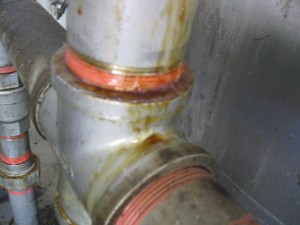That was a phrase that a plant engineer told me when he was helping me assemble our biodiesel plant. I thought I understood what he meant at the time, but now I have a much, much deeper understanding.
Biodiesel is an amazing liquid. Pure, finished biodiesel is non-toxic, biodegradable, and non-flammable, yet it will combust like diesel fuel. You can drink it (although I certainly do not recommend it), you can spill it on your lawn (I did, but accidentally; again, don’t do this) with no harmful effects, but it will not light with a match. It’s a very stable, safe liquid. Yet it will dissolve rubber compounds easily, destroy asphalt very quickly, degrade concrete, and react with certain metals. How is it you can drink this stuff, but it will destroy asphalt in a matter of minutes?!
But that’s not even what I’m talking about when I say it defies physics. When plumbing up our plant, we used a number of different pipe sizes, some in stainless steel, some in carbon steel. In most cases we used threaded pipe sealed with pipe tape. We quickly learned that it wasn’t sufficient to use the regular pipe tape you find a Lowe’s hardware. Even now, we have some pipe assemblies that were sealed with plumber’s paste AND military grade Teflon pipe tape and they still have a small leak when under pressure.
I can hear you saying it now, “Well dummy, just tighten the connection”, or “You just didn’t do it right. Put more (or less) tape”. I’ve heard all that. Unless you actually RUN a biodiesel plant, it’s probably hard to believe what I’m saying. In fact, about the ONLY thing that really seals pipe connections is to go back and put a weld around each pipe connection. That seems to do the trick.
We’ve even seen biodiesel creep through tank patches where a 1/4″ steel plate was welded to a tank. I presume because biodiesel has such a high lubricity, that it can just “slide” through cracks and pin holes that other liquids are not able to penetrate. It definitely seems to be more prevalent with stainless steel fittings than black steel, and high temperature and pressure exacerbate it by a good margin. On the wash side of our plant where we have black pipe instead of stainless, it seems to occur less. The stainless steel connections shown in this picture below are a good example of stainless steel threaded connections that run hot biodiesel through at pressure. We regularly clean these connections down, but they continue to seep ever so slightly. Tightening does not help, and in some cases we’ve redone the connections completely, to no avail.

I’m betting there actually is a perfectly good scientific explanation for why this liquid behaves this way. It’s probably not even that unique. But it makes for a better headline to make biodiesel sound more mysterious (hey, I’m learning from our mainstream media).
So if you’re building a plant, or even a small reactor for yourself, do take care to make sure all your steel pipe connections are very tight and well sealed. They will leak, eventually.
In the mean time, we have regular cleanups to do and some long term pipe welding projects ahead…
